Combining H&S EntriesAuctions starting with a heart bid have a lot of in common with those starting with a spade bid. The same is true to a lesser extent for clubs and diamonds mainly because an opening 1H or 1S normally promises a suit with 5+ cards while C or D opening bid may have as few as 3 cards in the suit. (Fewer, for some conventions.) For example, bidding entries for 2/1 Game Force, Bergen Raises, Jacoby 2N Raises, and many others, all have to be duplicated in the sections for 1H-P and 1S-P (Prior Bids). All the follow-ups to those bids also have to be duplicated. Not only does this increase the size of BidBase, but it also greatly increases the chances for inconsistencies and other errors. For a long time (decades), given the way BidBase was set up, it didn't seem possible to combine such sections in a way that would keep the basic design of the database relatively simple, and in fact, there is normally a trade-off between simplicity and efficiency. What changed was in late 2022, it was noticed that when using "Systems On" for notrump overcalls (e.g.: "1C-1N-P"), most of the bids by responder are the same as after "1N-P" creating the same problems of wasted space and errors. So BidBase was modified to look for responses to an overcall of 1N in the same section as responses to an opening 1N. (See more details.) This has worked so well that the idea has been expanded to combining entries from the 1H-P and 1S-P sections into a "1M-P" section (likewise for 1M-1N, 2M, 3M, etc.). And the 1C-P and 1D-P (etc.) sections have been combined into a "1m-P" section. For example, Prior Bids of 1H-P are passed to the BB bidding module. It changes the 1H-P Prior Bids to 1M-P and looks for an entry with hand specs matching the current hand in the 1M-P section. If an entry is not found in 1M-P, it changes 1M-P back to1H-P and looks in the 1H-P section. If an entry is still not found, it passes. The reason for it checking the 1H-P section after the 1M-P section is that for some responses, it may not be feasible to combine responses to both 1H-P and 1S-P into one entry for 1M-P. Those kinds of entries are still in the 1H-P and 1S-P sections. Confusing? Probably, and that is not something taken lightly because the whole point of the database approach for BidBase is that you can usually tell at a glance what each entry means, and the M shortcut requires a little brain work. If you read through this document and find things too confusing, the good thing is that this is optional when adding new entries. Anything that can be accomplished by combining the hearts and spades entries can be done by just making separate entries for hearts and spades. But the payoff in BidBase's consistency by combining them was just too great to ignore, and it just boils down to these steps:
Examples:(1) First is an example of an entry which would not be made into an M entry: where responder needs to bid 1S after an opening 1H-P: The purpose of the entry below was to make a 2/1 Forcing bid with only 11 HCP but with a good 6-card or longer suit. If Prior Bids were 1S-P and responder's suit is hearts, he can bid 2H and all is good. But if Prior Bids were 1H-P and responder's suit is spades, he should only bid 1S (which, however, is obviously not a 2/1 bid), not 2S (which would likely show either a weak or strong jump-shift, not the hand specified in this entry). So what we would do instead of making the entry below is to make an entry in the 1S-P section without the "x" in the Spds Num field. In the 1H-P section are any entries in which 1S or 1N are bid after 1H-P.
This is an ideal entry for an M section because the major suit is not being bid, so there cannot be any problem with H and S resulting in inconsistent bids, which is not to say that the M suit should not ever be bid in an M section, and examples of such entries will be seen below.
Since BB looks in 1M-P first, if it finds an entry matching the specs of the hand, it will use that entry and never look in a 1H/S-P section. If you need it to use an entry in a 1H/S-P section, you may have to remove the entry from the 1M-P section and replace it with entries in the 1H-P and 1S-P sections or edit the entry in the 1M-P section so that the hand no longer meets the required specs.
The box framed in red on the right side shows the suit specs in the original entry in the 1H-P Prior Bids section. In the Combo Points box is "Hx=10+". This means that the HCP for the Hearts suit + the "x" suit (diamonds, in the Test Hand) total 10+. The minimum for the two suits is 3 and for the x and M suits combined is 10, if the x suit has 3, the M suit must have 7+ (or vice versa), or it could be 4 and 6, or 5 and 5.
In the combined entry, 1H-P was changed to 1M-P, the Combo Num box says "M4+" so that whether the actual Prior Bids was 1H-P or 1S-P, the "x" in the suit's Num box will be changed to "4+". The Num for the major suit not being changed to 4+ will keep the "x" and if that suit has 5+ cards with 3+ HCP (or if D or C has 5+ and 3+), then that part of the entry's specs are met. That is, for this entry, if the M suit is hearts, the spades suit is still tested to see if it has 5+ cards with 3+ HCP. Likewise, "Hx=10+" was changed to "Mx=10+", meaning that if the actual Prior Bids were 1H-P, then "Mx10+" is changed to "Hx10+" and if the Prior Bids were 1S-P, then it is changed to "Sx10+". This change does not affect the Suit Specs line because "Hx=10+" is still a Combo spec for the points for H + the points for whatever suit matches the "x" spec. In the Test Hand in the entry above, diamonds are the suit matching the "x" spec of 5+ cards and 3+ HCP. So the actual 3 HCP in H plus the 7 HCP in D = 10 HCP and the Combo spec of 10+ is met. The original spec of hearts Points = 3+ was necessarily lost, but the Combo spec of Mx=10+ pretty well covers that. No harm, no foul.
Each suit starts with "x,3+" for Num and "3+" HCP and the "x" specification is "<2". If Prior Bids were 1H-P, then before testing begins, the Combo spec of "M4+" will cause "x,3+" for hearts to be replaced with "4+". Every other suit must either have 3+ length with 3+ HCP or have fewer than 2 cards. If Prior Bids were 1S-P, then "x,3+" for spades is replaced with "4+". The bid of "4x" means that whichever suit matches the x specs will be bid on the 4 level.
Before testing this entry, assuming Prior Bids of 1 It works the same way if Prior Bids were 1S-P and we are looking for heart shortage to cover "H:xxx+". Spds Num would be changed to 4+ and the Hrts specs would remain "3+" with "<1" Points.
In the entry below, with 5+ of the M suit, a raise to 4M (H or S) is called for, but if we put "x" in both the H and S Num fields, it's possible that the wrong major could have 5+ and the bid would be made. If the Combo field had "M5+" in it, the correct suit would have "5+" in its Num field, but then we would have to put 4M in the Bid field so that either H or S would be bid as appropriate. This would require extra code. By putting "Mx" in the Combo field, the "x" will only be put in the correct major's Num field. Since no other Num field will have an "x", only the M suit will be tested for "x" and when "4x" is bid, the program already knows to make that the suit matching the "x" spec. Note that if using the Ctrl-Y box to enter a hand to find this bid for, you must enter the Vulnerability and Position as shown in the entry or it will return "Bid not found". Likewise, if BidBase is bidding a hand in the Practice program, it will not make this bid unless the deal's specs are set as shown.
Below is a similar entry. In this case, the M suit's (H or S) Num spec will be replaced with "x" leaving the other major's Num-Points specs to be "4+" and "A,K". When these specs are met, the bid will be 4 of the M suit, since that is the only suit with an "x".
As previously noted, this is somewhat complicated, but the casual user never sees all the behind-the-scenes complications. If searching for a bid, he enters the actual Prior Bids, such as 1H-P, and the hand to be bid, and BidBase returns the bid found whether the entry is in the M section or the H/S section. Other comments:
The 2/1 Forcing convention remains in separate 1H-P and 1S-P sections because the large majority of the entries are not interchangeable between the two.
|

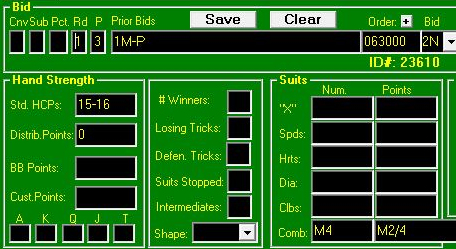
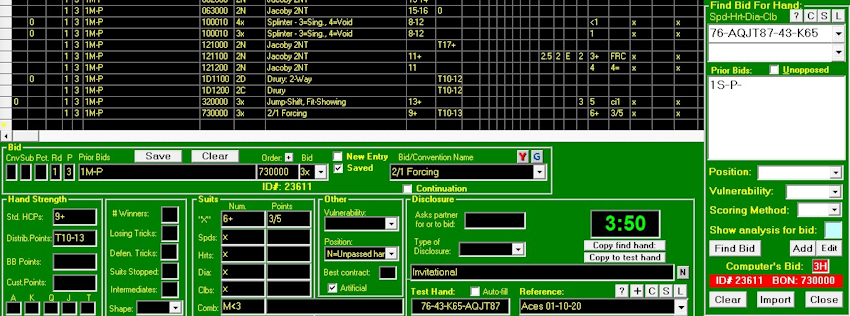 Referring to the screen shot above:
Referring to the screen shot above:
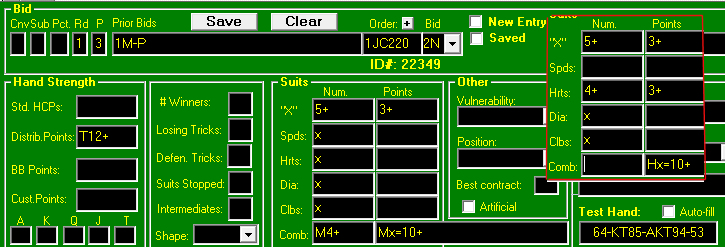
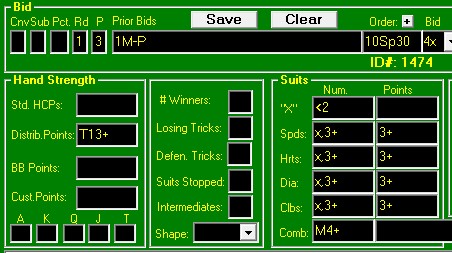 Example:
Example:
 KQ743
KQ743  A952
A952  5
5  K64
K64
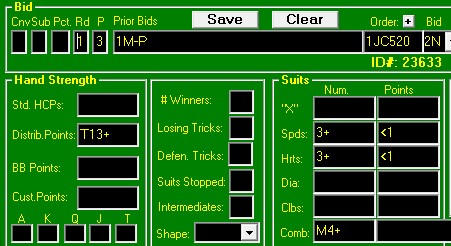 (6) Compare the entry above to the one on the left which is only concerned with finding out if partner has shortage in spades to cover a hand like
(6) Compare the entry above to the one on the left which is only concerned with finding out if partner has shortage in spades to cover a hand like  -P, the Combo spec of M4+ will replace the Hrts Num of 3+ with 4+. The Hrts Points spec of "<1" is automatically removed at the same time since no other specs were made for the M suit in Combo.
-P, the Combo spec of M4+ will replace the Hrts Num of 3+ with 4+. The Hrts Points spec of "<1" is automatically removed at the same time since no other specs were made for the M suit in Combo.

